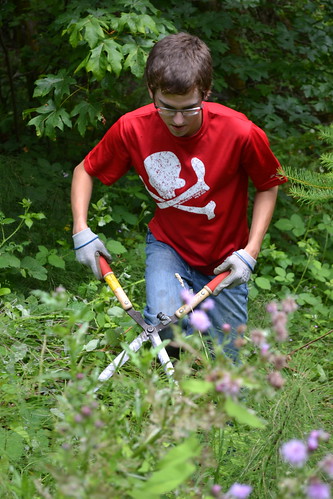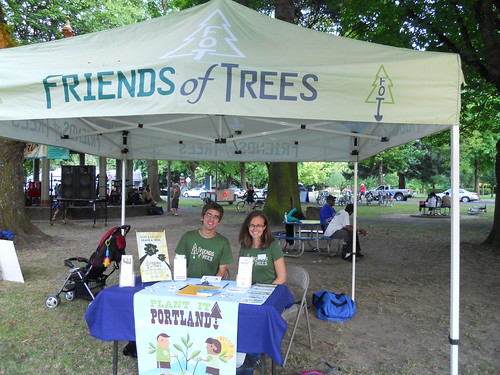Engaging with FOT all summer: a recap

By Michael Migotsky
Now that my time at Friends of Trees has come to an end, I thought I’d reflect back on my work in all the different areas of the organization. This is the first of a two-part recap of my summer. This post is more factual, while the second post will be more reflective and personal.
If you have ever had FOT plant at your house or volunteered at a planting, you’re probably already somewhat familiar with the Neighborhood Trees (NT) program. My work with this program was mainly in maintenance, rather than planting, because all of the plantings are during the cooler, wetter months to help the new trees grow better.
I spent part of my time as a summer inspector, going out around the neighborhoods and checking up on trees, making sure that they were healthy and that the homeowners had been taking proper care of their trees. If you’ve planted with us, you probably remember getting a yellow door hanger from a summer inspector telling you how you’re doing as a new tree owner.
For some of the older trees, I also took measurements so Friends of Trees can tell quantitatively how well the trees are doing once the trees have been established. I also helped water trees, deliver yard signs, take pictures of trees, enter tree data, and check up on trees that weren’t doing so well based on that data. Hopefully you haven’t ever seen me on one of those routes.
Additionally, I put inserts into over 4,000 door hangers for the Bureau of Environmental Services inspectors. So if you are currently waiting for the city to inspect your curb and say how many and where you can plant trees, you will probably receive a door hanger that I have assembled.

Another area I helped out in (and that some of you might have helped out in, too) is the Green Space Initiative (GSI). As with NT, my work was mainly maintenance, as the summer was not the planting season. Instead, I did a lot of “daylighting,” that is, cutting away grass and other plants that had started to overgrow the native plants that Friends of Trees planted.
Unlike NT, most of the GSI plants are smaller native shrubs and trees, which have been planted in different green spaces around the area to help reestablish native plants where invasive species may have taken over. Beyond daylighting, I also helped mulch and water the plants. Just as your new street and yard trees need weeding, water and mulch to establish themselves, so do the GSI plants.
Finally, along with helping native plants survive, I cut back invasive plants, mainly Himalayan blackberry. While we are Friends of Trees (and of native plants), we are not friends of invasive species.
Beyond these two more outdoor, field-based activities, I also helped with office work. Other than entering data and assembling door hangers for NT, I helped track donors, stuffed envelopes with our annual report in them, and wrote these blog posts. I also entered data about volunteers and future plantings, looked into further partnering with local colleges and universities, and attended an outreach event at a Concert in the Park.
As you can see, my summer with Friends of Trees was full and varied, and I have done and learned a lot.
–Migotsky was a DukeEngage intern with Friends of Trees this summer.
